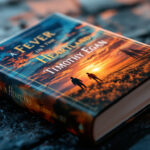The One and Only Bob by Katherine Applegate – A Heartfelt Book Review
If you loved The One and Only Ivan, then The One and Only Bob is bound to tug at your heartstrings. Katherine Applegate brings us back to this world through the eyes of Bob, Ivan’s loyal yet scrappy canine friend. This time, the story isn’t just about survival—it’s about finding courage, rediscovering trust, and realizing the true meaning of family. With humor, honesty, and plenty of emotion, Bob’s journey is one that reminds us all of the power of friendship and resilience, even when life throws the unexpected your way.
Overview of The One and Only Bob
Katherine Applegate brings her signature heartwarming storytelling to The One and Only Bob. As a follow-up to The One and Only Ivan, this novel delves into the spirited and scruffy world of Ivan’s canine companion. With humor, emotional depth, and a strong focus on relationships, Bob takes readers on an unforgettable journey of self-discovery and resilience. Let’s break down some key elements of the book.
Who is Bob?
Bob is more than just a scrappy stray dog—he’s a survivor with a quick wit and a heart that’s bigger than he lets on. Once abandoned as a puppy, Bob grew up navigating the streets, learning how to fend for himself in a tough world. His rugged independence contrasts with the loyalty he shows to Ivan, his best friend, and Julia, the young girl who eventually becomes his family. Despite his bravado, Bob wrestles with insecurities stemming from his rough past. Through his experiences, he embodies the idea of finding love and family in unexpected places, proving that even those with guarded hearts can grow and heal.
To dig deeper into Bob’s background, check out this review of the book.
The Storyline
At its core, the story paints a vivid picture of Bob’s life. Now a cherished house pet, Bob’s journey begins on a seemingly ordinary day when a hurricane changes everything. He’s forced to confront not only the physical challenges of the storm but also emotional truths he’s long avoided. As Bob faces a series of trials alongside familiar faces like Ivan and Ruby, he discovers hidden reserves of courage and the true meaning of loyalty.
While avoiding spoilers, it’s worth mentioning that the story’s pacing and rich detail keep readers deeply engaged. From moments of nail-biting tension to heartfelt reunions, The One and Only Bob delivers an emotional rollercoaster. For more about the storyline and its highlights, see this review on Common Sense Media.
Themes Explored
Applegate weaves meaningful themes into Bob’s narrative, making this book resonate with readers of all ages. Here are a few standout themes:
- Friendship & Loyalty: The bond between Bob, Ivan, and Ruby plays a central role, showing how true friendship means being there even in the darkest times.
- Family: Bob’s relationship with Julia and her family highlights the importance of belonging and how family can be found, not just born.
- Forgiveness: As Bob reflects on past hurts, the story emphasizes the power and healing that comes with forgiveness.
- Overcoming Trauma: Bob’s struggles to confront his past and trust others again serve as a reminder that growth often comes through vulnerability.
For readers interested in a detailed thematic analysis of this book, the SuperSummary guide provides additional insights.
Bob’s adventure isn’t just a dog’s tale; it’s a universal story about love, bravery, and second chances. Whether you’re familiar with The One and Only Ivan or starting fresh with this book, Bob’s journey is a heartfelt reminder that everyone has a story worth telling.
Writing Style and Narrative Perspective
Katherine Applegate’s writing in The One and Only Bob brilliantly captures the thoughts and emotions of its canine narrator. The story unfolds through Bob’s eyes, offering a fresh and heartfelt perspective that readers of all ages can connect with. Let’s take a closer look at some of the elements that make the narrative style so engaging.
Short Chapters and Creative Voice
One of the standout features of The One and Only Bob is its use of short, punchy chapters. This structure keeps the pacing brisk and makes the book accessible, particularly for younger readers or those who may struggle with longer texts. Each chapter feels like a quick conversation with Bob—undemanding yet packed with personality. The brevity here isn’t a limitation; rather, it acts as a rhythm that mirrors Bob’s sharp and witty inner monologue. The result? Easy-to-digest sections that make readers eager to keep flipping the pages.
Bob’s voice is another element that truly sets this novel apart. He narrates with a mix of humor, sass, and vulnerability, painting a vivid picture of his world as a scrappy, streetwise dog. His tone is conversational and direct, making you feel like a trusted confidant. At times, it’s almost like reading a diary but with a splash of stand-up comedy thrown in. This unique voice doesn’t just make Bob likable—it makes him unforgettable.
For more insight into how Applegate crafts such compelling perspectives, check out this analysis of her writing style.
Glossary of Dog Terms
Adding to the book’s charm is the inclusion of a “canine glossary.” This playful feature introduces readers to a collection of humorous, dog-centric terms woven into Bob’s narration. It’s not just a quirky add-on—it helps immerse readers in Bob’s world. Terms like “bed boogie” and “water bowl of power” aren’t just fun; they’re smart ways to deepen the connection to Bob’s point of view, giving us a playful glimpse into how he interprets everyday life around him.
This glossary also creates moments of levity in the narrative, balancing the heavier themes of courage and self-discovery. Younger readers, especially, will enjoy decoding Bob’s lingo, and it’s likely to spark a few giggles. Think of it as a secret language shared between Bob and the audience, adding a layer of intimacy to the storytelling.
To explore some entries from Bob’s canine glossary, you can visit this fun glossary resource.
With its snappy chapters and clever use of language, The One and Only Bob exemplifies how a well-chosen narrative perspective can make a story not only accessible but also deeply engaging. Katherine Applegate’s attention to detail and playful approach give this book a voice that sticks with you long after you’ve turned the final page.
Comparison with The One and Only Ivan
Katherine Applegate’s The One and Only Bob serves as a fitting continuation of the heartfelt world introduced in The One and Only Ivan. While both stories capture emotional depth and character growth, Bob’s tale provides a fresh perspective while retaining the core emotional elements that made Ivan’s journey unforgettable.
Character Development: Focus on how Bob’s character grows in contrast to Ivan’s journey in the first book
Ivan’s growth in The One and Only Ivan is largely about reclaiming his identity and purpose. He transitions from a gorilla resigned to captivity to one who finds his voice, ultimately leading to a better life for himself and Ruby. His journey focuses on strength through vulnerability—a silverback learning to embrace his strength again not just for himself, but for others.
Bob’s evolution, on the other hand, is deeply inward. As a scrappy street dog, he starts with a shield of sarcasm and rugged independence, avoiding emotional connections whenever possible. Yet, The One and Only Bob forces him to confront unresolved trauma from his abandoned past. Bob’s growth feels more personal, as he struggles not just with external challenges but with owning his place in a family and learning to trust. It’s less about physical strength, like Ivan’s tale, and more about emotional courage.
Bob’s character arc is a testament to how difficult it is to let go of the past—but also how rewarding it can be when you finally do. For an insightful breakdown of Ivan’s character and growth in the original book, refer to this character analysis from LitCharts.
Emotional Impact: Discuss how the sequel handles emotional elements compared to the original
The One and Only Ivan was a sucker punch of emotions, thanks to its poignant exploration of captivity, freedom, and friendship. Applegate masterfully balanced the sorrow of Ivan’s life in captivity with glimmers of hope and connection. Readers often walked away feeling both uplifted and reflective about the story’s real-world parallels to animal conservation and captivity.
In contrast, The One and Only Bob shifts its emotional focus from larger societal themes to a more intimate exploration of identity and belonging. Bob’s story delves into themes of loyalty, forgiveness, and family. While not as grand in scope as Ivan’s tale, the sequel resonates deeply with readers on a personal level. Bob’s raw and often humorous narration provides a lighter tone at times, but this doesn’t take away from moments where the weight of his past tugs at readers’ hearts.
Interestingly, for some, the more intimate, family-oriented elements in Bob’s journey might hit closer to home, especially for younger readers navigating feelings of insecurity or searching for belonging. For an overview of how The One and Only Bob handles emotional storytelling, check out this detailed review by Café Society.
Whether it’s Ivan’s quiet resilience or Bob’s unapologetic bravery, both characters leave readers with a strong emotional connection, reminding us that courage comes in many forms.
Key Highlights and Memorable Scenes
In The One and Only Bob by Katherine Applegate, some moments strike a deep chord with readers, reflecting Bob’s journey of resilience, loyalty, and emotional growth. Two pivotal scenes—one involving a hurricane and another where Bob reunites with his sister—capture the raw feelings and themes of the book, making it unforgettable.
The Hurricane Scene: Describe the intensity of the hurricane scene and its symbolic importance
The hurricane in The One and Only Bob isn’t just an act of nature—it’s a metaphor for the chaos in Bob’s life and his inner struggles. As the storm approaches, there’s a palpable tension, both in the air and within Bob himself. The winds howl, trees bend, and rain lashes against everything in its path, mirroring the whirlwind of emotions that Bob has been suppressing for so long.
During the hurricane, Bob is swept away, physically separated from the comfort and safety of his human family, Julia, and his best friend, Ivan. This separation acts as a turning point. Struggling to survive amid the storm’s destruction, Bob confronts the vulnerability he likes to hide beneath his scrappy, tough-dog persona. His instinct to protect, even in the most harrowing moments, showcases his growth as a character and his deepening sense of responsibility.
The symbolism in the storm is also hard to miss. It represents Bob’s journey of rediscovering trust, shedding the past, and embracing his role in his found family. Much like the aftermath of the storm reveals a clearer sky, Bob emerges with a stronger bond to those he loves and a better understanding of himself. For a detailed breakdown of this scene, check out this review on Greenish Bookshelf.
Bob’s Reunion with His Sister: Discuss the emotional depth of Bob finding his sister and how it impacts his growth
When Bob finally reunites with his sister Boss, it’s an emotional gut punch. After years of assuming he’d never see her again, their meeting is both surprising and profound. Boss’s introduction doesn’t come until later in the story, but her presence immediately shifts the narrative. The siblings, despite their shared history of abandonment, took very different paths in life, which adds depth to their reunion.
Boss’s resilience and ability to survive independently shed new light on Bob’s personality. While Bob has found safety and love with his human and animal families, Boss has remained fiercely independent. This stark contrast sparks both admiration and self-reflection in Bob. He begins to see that his past doesn’t define him, and his reunion with Boss helps him finally let go of the lingering guilt and fear of abandonment that have haunted him for so long.
Their meeting also highlights the theme of family—both the kind you’re born into and the kind you choose. Boss’s unwavering confidence reminds Bob of his own inner strength, solidifying his journey of emotional growth. If you’re looking for more insight into this heartfelt moment, this review on Elaine Donadio Writes provides a deeper look at its significance.
These two scenes—the hurricane and the reunion—serve as linchpins in Bob’s story. They reveal his true character, test his courage, and ultimately guide him to a place of acceptance and peace. Every page brimming with tension, they make The One and Only Bob a standout read for its raw emotion and undeniable heart.
Recommended Audience
Katherine Applegate’s The One and Only Bob caters to a wide spectrum of readers, thanks to its emotional storytelling and relatable themes. Whether you’re a middle-schooler exploring resilience or an adult who cherishes animal stories with heartfelt depth, this book has something special to offer.
Middle-Grade Appeal
Children between the ages of 8 and 12 will find The One and Only Bob engaging and accessible while also thought-provoking. The story has just the right mix of humor, action, and emotional depth to appeal to young readers at this formative stage. Bob’s witty personality and scrappy nature make him a relatable protagonist, especially as he grapples with questions about family, trust, and bravery—concepts that resonate strongly with kids navigating their own growing independence.
Moreover, the book’s pacing, with its short chapters and conversational tone, is perfectly designed for younger readers who might find longer books intimidating. The glossary of dog terms scattered throughout the story adds a fun and approachable element, encouraging children to immerse themselves more deeply in Bob’s world.
Topics like overcoming fear, embracing challenges, and learning to trust others deliver valuable life lessons in a way that feels organic and relatable rather than preachy. Parents and educators often praise the book for its ability to weave meaningful themes into a narrative that still feels lighthearted and entertaining. For a deeper look into how this book fits middle-grade readers, visit this Common Sense Media review.
Adults Who Love Animal Stories
Though written for younger audiences, The One and Only Bob strikes a chord with adult readers who enjoy heartfelt narratives about animals. Bob’s raw and candid voice exposes universal truths about love, loyalty, and healing from trauma—themes that mature readers can deeply appreciate. The book captures the complexities of emotions through the lens of its canine protagonist, offering a fresh perspective on humanity’s connection to animals and their own emotional journeys.
Additionally, the story is filled with moments that tug at the heartstrings, particularly for those who have ever shared a special bond with a pet. Whether it’s Bob’s vulnerability or his unshakable loyalty, his journey reminds us of why animals hold such a cherished place in our lives. The emotional depth of the storyline ensures that adults will find as much to gain from Bob’s reflections on courage and family as younger readers. For more on the book’s ability to resonate with adult readers, check out this Sis and Chrys review.
This combination of humor, warmth, and life lessons ensures The One and Only Bob is a cherished read for animal-loving adults while never feeling like it’s written exclusively for kids. Whether you’re young or simply young at heart, Bob’s story stays with you long after it’s over.
Strengths and Criticisms
Katherine Applegate’s The One and Only Bob brings an exceptional mix of warmth, wit, and emotion, but it’s not without a few bumps along the way. Let’s explore what makes this book shine and where it slightly falters.
Strengths: Engaging Storytelling, Strong Themes, and Bob’s Unique Voice
One of The One and Only Bob’s crowning achievements is its ability to balance humor, heartache, and heroism. Applegate’s storytelling captures the reader’s attention from the very first page, weaving a narrative that is as engaging as it is meaningful.
- Bob’s Unique Voice: If there’s one thing that sets this novel apart, it’s Bob himself. His scrappy, sarcastic tone feels entirely human—yet distinctly canine. This unique narrative voice draws readers closer, creating a connection that feels personal. Bob’s wit and vulnerability make him both entertaining and relatable, offering a perspective that enriches the entire story. For another take on Bob’s voice, check out this Greenish Bookshelf review.
- Strong Themes: Applegate doesn’t shy away from tackling significant themes. From finding courage amidst chaos to examining the meaning of family, the book resonates with readers of all ages. Bob’s journey is rooted in themes of forgiveness, loyalty, and self-discovery, making it emotionally impactful without being heavy-handed. The narrative gently reminds readers how bravery often lies in vulnerability.
- Engaging Storytelling: Short, quick chapters build a rhythmic pace, keeping readers hooked while still allowing moments of introspection. This format is especially effective for younger readers who may find dense texts intimidating. The story’s blend of danger during the hurricane, reunions, and heartfelt moments ensures there’s never a dull moment. For more about these narrative strengths, see this review by Elaine Donadio.
Criticisms: Slow Start and Comparisons to the Original
While The One and Only Bob excels in many areas, it isn’t perfect. A couple of drawbacks may leave some readers wanting more.
- Slow Pacing at the Start: The first few chapters, though charming, may feel slow for readers expecting immediate action. Bob reflects on his life and relationships, which adds depth to his character, but it takes time before the main plot kicks into gear. Some readers might wish for a more engaging opening to match the intensity of the later chapters.
- Comparisons to The One and Only Ivan: Inevitably, this sequel is often compared to its predecessor. While Ivan’s story carried a weighty message about captivity and animal welfare, Bob’s journey is more personal and introspective. For some readers, this shift in focus might feel less impactful. Additionally, Bob’s humor, though endearing, can occasionally dilute the emotional gravity, especially when held up against Ivan’s poignant tale. For a deeper comparison, consider this Redeemed Reader review.
Overall, The One and Only Bob stands as a worthy follow-up that expands on beloved characters while offering new insights. However, its pacing and scope make it different from, though no less delightful than, The One and Only Ivan. Both books leave lasting impressions but in distinct ways—reminding us that every story, and every voice, has a unique way of connecting to the heart.
Conclusion
Katherine Applegate’s The One and Only Bob is a testament to storytelling that bridges themes of courage, family, and the healing power of love. Bob’s scrappy, heartfelt journey brings both humor and depth, making it a meaningful follow-up to The One and Only Ivan. With its relatable lessons and accessible style, it’s a perfect choice for young readers and adults alike.
Whether you’re revisiting old friends or meeting Bob for the first time, this story is a reminder of life’s unexpected joys and second chances. Don’t just stop here—pick up both books and let Bob and Ivan’s unforgettable adventures inspire you. What moment stood out to you most? Share your thoughts below!







